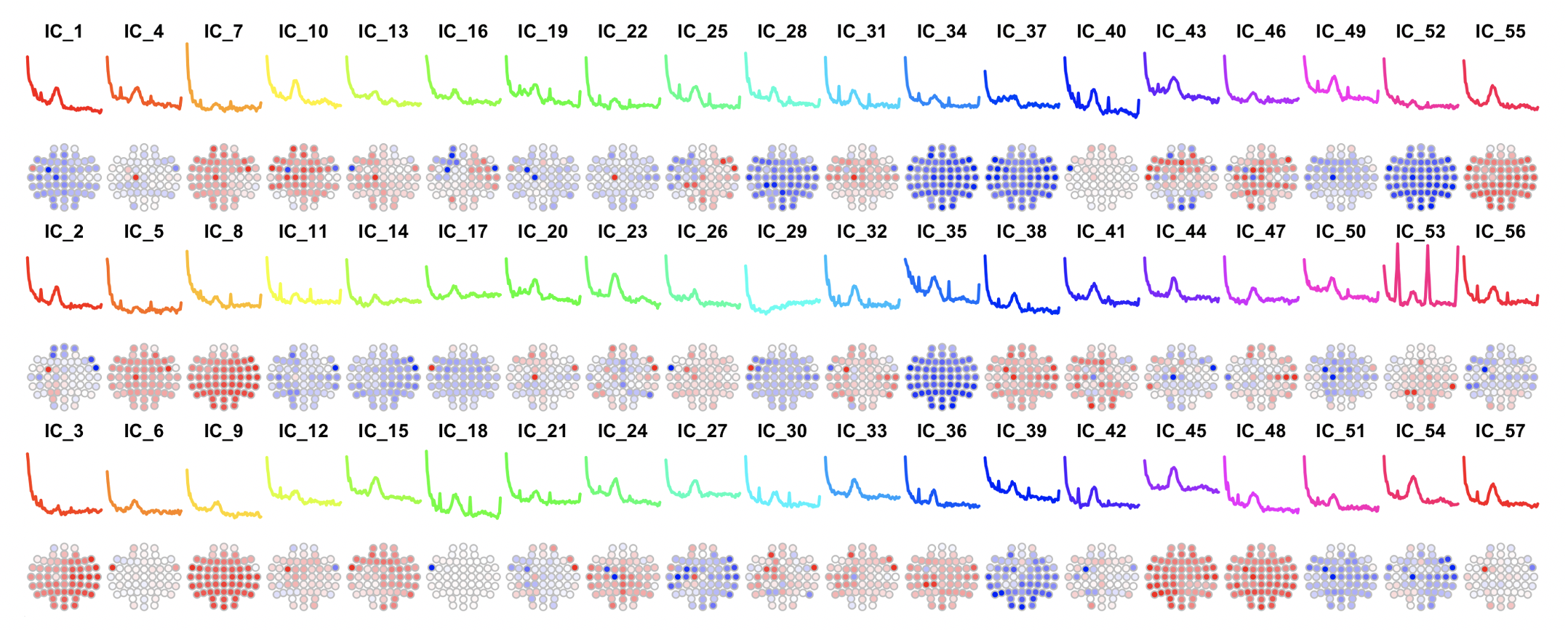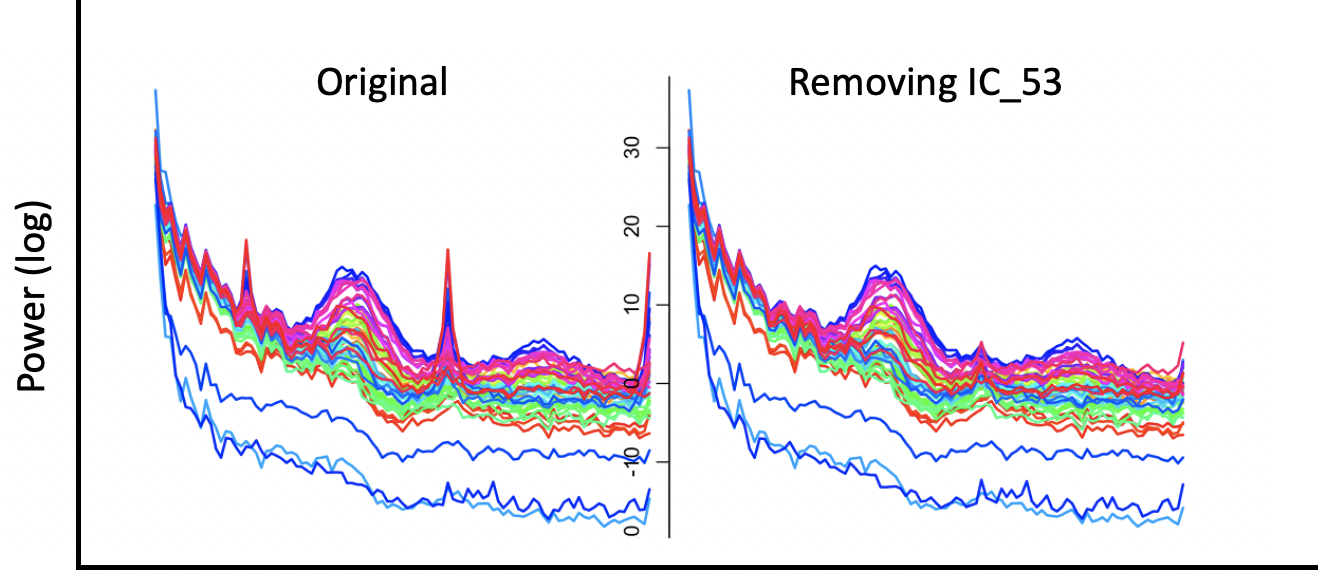Independent components and principal component analyses
An implementation of the fastICA algorithm
| Command | Description |
|---|---|
ICA |
Fit ICA model to signal data |
ADJUST |
Adjust original signals given one or more ICs |
SVD |
Apply time-series PCA to multiple channels |
ICA
Independent components analysis
This command implements the fastICA algorithm, providing a C/C++ implementation of R's fastICA package.
We hope that in future vignettes we will be able to provide a more contextualized account of how to apply ICA using Luna to sleep data in practice. For now, this page contains only bare-bones reference material.
By default, ICA adds signals IC_1, IC_2, etc to the internal
EDF: these can then be used as signals in other commands (e.g. PSD)
to examine the properties of those components. You can also WRITE
the EDF containing these ICs.
Currently, this command works on a whole-recording basis, e.g. rather than epoch-by-epoch. This may not be appropriate if the whole recording contains very different types of signals/artifatcs (i.e. if the spatial sources of the components is not relatively stable over time).
Hint
Remember that ICA is not a deterministic algorithm, in that
it is randomly seeded. Therefore, IC_4 in one run may not
correspond to IC_4 in a second run. It is therefore important to
save the results of an ICA run, e.g. if determining which
components to remove, etc.
Hint
ICA can be a relatively slow and memory intensive operation for whole-night multi-channel datasets with high sampling rates. It is therefore worth exploring this command starting with smaller and/or down-sampled data, etc.
Warning
Although implementations of ICA are standard, the proper application of ICA to multichannel EEG data is a complex methodological area, with various subtleties. These routines are currently presented 'as is'. In the future we will attempt to outline some best practices for using ICA (primarily for artifact detection) in the context of sleep data.
Parameters
Primary parameters are:
| Option | Description |
|---|---|
sig |
Specify which signals to include |
A |
Filename for the mixing matrix A |
nc |
Optionally, the number of components to extract |
Secondary parameters include:
| Option | Example | Description |
|---|---|---|
no-new-channels |
Do not write new channels to EDF | |
tag |
V_ |
Use V_1, V_2, etc, instead of IC_1, IC_2, etc |
file |
ica1 |
Write ICs (S matrix) and other ICA output to files ica1.S, etc |
Outputs
As mentioned, one output of ICA is a set of new channels added to
the (internal) EDF (unless no-new-channels is specified). These are
labelled IC_1, IC_2, etc, by default.
A second key output is the mixing matrix A, which is written to a
file. A typical workflow will involve using this matrix/file in a
subsequent ADJUST command, in order to remove certain components from
the original signals.
Various other outputs are written to the standard output stream:
ICA mixing matrix (also output to a file) (strata: CH x IC)
| Variable | Description |
|---|---|
A |
Element of A matrix |
ICA unmixing matrix W (strata: IC1 x IC2)
| Variable | Description |
|---|---|
W |
Element of W matrix |
ICA matrix K (strata: KCH x KIC)
| Variable | Description |
|---|---|
K |
Element of K matrix |
Example
Running ICA on a single EDF:
luna s.lst k=57 -o out.db -s ' MASK ifnot=N2
& RE
& ICA sig=${eeg} A=a.mat
& PSD sig=[IC_][1:${k}] spectrum dB
& WRITE edf-tag=ic '
Hint
Note that [X][1:4] expands to X1,X2,X3,X4
We can visualize the PSD of the ICs by extracting the information in
destrat out.db +PSD -r F CH > psd.out
ltopo.rb() or similar functions to view these:

Here we see that some components are highly channel-specific (i.e. as
indicated by the topoplots, e.g. IC_18). Looking at the PSD, some
ICs appear to reflect artifact, e.g. IC_53. We can use the ADJUST
command to remove certain components from the original signals, as
illustrated below.
ADJUST
Adjusts signals given various ICs and other criteria
This command is designed to work with ICA, and expects as input a)
the same signals used to compute the ICs, and b) the A matrix from
an ICA run. Based on these, the ADJUST command will remove certain
components from the original signals. One can specify the
components directly on the command line (e.g. IC_53).
Alternatively, it is possible to instruct ADJUST to select
components to be removed automatically, based on certain criteria.
Currently, only two criteria are supported: topographical outliers and
high correlation with one or more other channels (e.g. EOG or EMG).
Parameters
| Parameter | Example | Description |
|---|---|---|
sig |
Signals to be adjusted | |
A |
a-id1.txt |
Filename of A mixing matrix (from ICA) |
adj |
[IC_][1:57] |
Putative set of ICs that may be adjusted for |
force |
IC_5 |
Force this component to be removed |
spatial |
3 | Select components with extreme spatial variance |
corr-sig |
LOC,ROC |
Other signals aginst which ICs will be correlated |
corr-th |
0.8,0.8 |
Absolute time-domain correlation threshold (matches # of corr-sig channels) |
tag |
V |
If the IC prefix is other than IC_ it can be specified here |
Output
This command primarily adjusts the channels in the (internal) EDF, rather than generating summary output. Currently, the one output that is given is the correlation between the original and the adjusted channel:
Channel-level output (strata: CH)
| Variable | Description |
|---|---|
R |
Time-domain correlation between the pre- and post-adjusted signal |
Example
Following from the ICA example above, to remove channel IC_57 (and show before and after PSDs) we might write:
luna file-ic.edf -o out.db -s ' TAG ver/pre
& PSD sig=${eeg} spectrum dB
& ADJUST A=a.mat sig=${eeg} adj=${ic} force=IC_53
& TAG ver/post
& PSD sig=${eeg} spectrum dB '
In these example data, the pre- and post-ICA PSD are as follows:

To drop ICs that show time-domain correlations above some threshold with one or more other channels (e.g. EOG), one might use something like:
ADJUST sig=${eeg} adj=${ic} corr-sig=LOC,ROC corr-th=0.5,0.5
Hint
Luna defines channel types as IC components automatically
if they start with IC_, and sets an automatic variable ${ic}
that corresponds to these.
SVD
Singular value decomposition of time-series data (PCA)
This command performs PCA via SVD of multiple channels, and (optionally) adds new channels to the current in-memory EDF. All input channels must have the same sample rate. A specified number of new channels (with the same sample rate) will be added to the in-memory EDF.
Parameters
| Parameter | Example | Description |
|---|---|---|
sig |
C3,C4,F3,F4 |
Signals to be included in the SVD |
nc |
4 | Number of components to extract |
tag |
C_ |
Tag to add to new channels (e.g. C_1, C_2, etc) |
norm |
Normalize channels (to unit variance) prior to SVD | |
winsor |
0.02 |
Winsorize time series prior to SVD at this percentile (e.g. 2nd, 98th) |
no-new-channels |
Do not add new channels to the EDF |
Outputs
The primary output (unless no-new-channels is set) are the nc new
channels added to the EDF.
Primary per-component output (strata: C)
| Variable | Description |
|---|---|
W |
Singular value |
INC |
Is this componenent included (e.g. given nc) |
VE |
Variance explainend |
CVE |
Cumulative variance explained |
Component weights (right singular vectors) (strata: C x FTR)
| Variable | Description |
|---|---|
V |
Weight/right singular vector value |